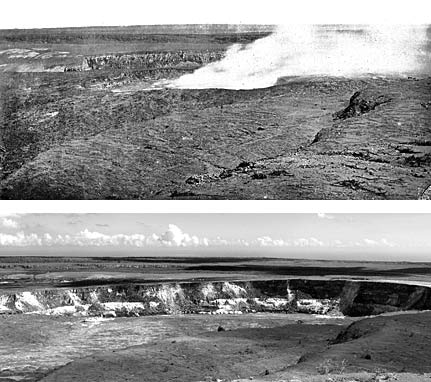140-year-old photograph
of Kilauea is discovered
The picture shows a volcano
much different from today's
HILO » The Hawaiian Volcano Observatory has discovered what might be the earliest photograph of Kilauea volcano, probably taken in 1865.
The photo shows an image of the steaming Halemaumau crater, the "fire pit" bubbling with lava, set in the larger caldera or bowl of Kilauea.
Geologist Don Swanson, who discovered the photo in observatory archives, compared the photo with the modern vista.

At top, a recently discovered photo, believed to have been taken in 1865, is the oldest known photo of the Halemaumau "fire pit," where steam is rising, in the broad Kilauea caldera. The cliff immediately behind it was unknown to scientists prior to the finding of this photo. The photo above shows Halemaumau crater as it appeared in 2004, twice as wide as it was in 1865 and with no cliff immediately behind it.
He also saw that Halemaumau was only half as wide in 1865 as it is today and more shallow. That was not a surprise, since it is known that explosive eruptions in 1924 greatly enlarged the pit.
Halemaumau is now about 3,500 feet across, set in 3-mile-wide Kilauea.
The back of the old photo had the notation: "First view of the volcano in the 60s," a reference that Swanson realized was to the 1860s.
Who took the photo is not certain. Swanson thinks it might have been shot by William Brigham in 1865, before he went on to head the Bishop Museum.
Brigham later wrote a book that included a description of his horseback trip to Kilauea starting Aug. 22, 1865, lugging a then-rare "photograph apparatus."
The weather was bad the whole time, except for Aug. 27.
That day, some people gathering pulu, the fluffy part of hapuu ferns used to stuff pillows and mattresses, told him "the names of various parts of the crater and legends of various eruptions."
Swanson thinks the photo might have been taken that day, but the Bishop Museum has no records from Brigham to confirm that.
"If any readers have relevant information, we'd certainly appreciate hearing it," his "Volcano Watch" column says.
[News] [Business] [Features] [Sports] [Editorial] [Do It Electric!]
[Classified Ads] [Search] [Subscribe] [Info] [Letter to Editor]
[Feedback]
